Guilder
![]()
The articles Gulden and Florentiner (gold coin) overlap thematically. Information that you are looking for here can also be found in the other article. You are welcome to participate in the relevant redundancy discussion or to help directly to merge the articles or to better distinguish them from one another (→ instructions).
![]()
This article is about the currency. For other terms, see Gulden (disambiguation).
The florin originally denoted a gold coin, but later also a unit of account and a silver coin. Therefore, a distinction is made between gold florins, invoice florins and silver florins.
From the first gold coin of this kind, the Florentine (Fiorino d'oro), Latin florenus aureus, derive both the names Floren or Florene (German), Florijn (Dutch), Florin (French and English) and Forint (Hungarian), as well as the internationally common abbreviations fl. or f. In contrast, in the south and west of the Holy Roman Empire the name Gulden (shortened from Middle High German guldin pfenninc or guldin pfennic) became established early on. or f. In contrast, the name Gulden (shortened from Middle High German guldin pfenninc or guldin pfennic) became established early on in the south and west of the Holy Roman Empire.
Term definitions
Note: The terms florins or florins are not always used unambiguously. There are coins that are referred to as such, e.g. the English florins of 1343/44, but which contain almost twice as much gold as the Florentine original. Often, quite generally, all gold coins were called florins or florins. On the other hand, there are coins which are not designated as such, but which obviously imitate it and correspond to it in gold content, e.g. the French Petit Royal Assis of 1291.
Invoice florins and silver florins
The transition from the gold guilder to the silver guilder often took place via the invoice guilder: The latter was created by simply maintaining the value of a gold guilder expressed in a smaller nominal, i.e. groschen, kreuzer, albus, etc., at a certain point in time, regardless of whether the underlying gold coin continued to rise or fall in value. In the course of the 16th century, the invoice guilders also began to be minted as silver coins.
guilder groschen
Due to the shortage of gold in Germany, Archduke Sigismund had silver coins worth a Rhenish gold guilder minted in the county of Tyrol from 1486. This coin, called Guldiner or Guldengroschen, became the forerunner of the silver guilder and the thaler. It had a pure silver weight of approx. 31.9 g and was divided into 60 kreuzers.
The first large silver coins minted in large numbers, the silver florins, were minted in 1500 in the Electorate of Saxony at the Annaberg/Frohnau mint and possibly at the Wittenberg mint. The bearded groschen minted in Zwickau and Schneeberg in 1492 and 1493, as well as the interest groschen minted in large quantities of 21 on the gold florins, especially in Schneeberg, from 1496 onwards, served to prepare the silver florin currency introduced from 1500 onwards. The trade had to be supplied with the corresponding quantity of small coins beforehand. The minting of the large silver coins was carried out according to the Saxon coinage regulations of 1500 (8.53 florins "on the fine mark"; weight 29.23 g; fine weight 27.41 g). The fine weight of the silver guilder corresponded in value to the gold value of the Rhenish gold guilder at that time until the first Saxon separation of coins. From 1505 to 1525, the Gulden was minted according to the modified minting standard of 1505: weight 29.23 g, fine weight 27.20 g. The silver Gulden was called "Klappmützentaler". The florins known as Klappmützentaler were also struck in the mints of Buchholz and Leipzig.
From 1518 onwards, the imperial barons Schlick in Joachimstal in Bohemia minted guldengroschen from the local mountain silver with the designation Joachimstaler, which were soon only called thalers and replaced the designation Guldengroschen of all these nominals.
In 1524 and 1551, at the imperial congresses in Esslingen and Augsburg, an attempt was made to create an imperial guldiner, which was to become the standard coin throughout the Holy Roman Empire. These Reichsguldiner are to be regarded as forerunners of the Talers and not the Gulden because of their size, their valuation at 63, respectively 72 Kreuzers and their link to the Goldgulden. They were hardly ever minted because the Saxon, Bohemian and other guldengroschen already circulating in masses were issued according to a somewhat lighter coinage foot and it would have been far too expensive and time-consuming to withdraw them and re-stamp them according to the imperial foot.
Invoice guilder
The Reichs-Rechnungsgulden
From the very beginning, the silver guilder, which was soon only called guilder, was understood as a summary of 60 kreuzers. This also corresponded to the value of the gold guilder at that time. Since fraudulent minters continued to increase their profits in minting coins into the 19th century by adding less and less silver, especially to the smaller denominations - those for the "common people" - the value represented by sixty kreuzer pieces slowly but steadily declined. The result was that the florin actually minted later, the specie florin, increased in value relative to the small coins while the silver content remained the same, while the invoice florin declined along with them.
The florin first appears as an invoice coin in the imperial treaty of 1551: of the new imperial florin, 864⁄127 silver was minted from the fine Cologne mark (233.856 g). But since it had been set at 72 kreuzers, a fine Cologne mark in invoice gulden at 60 kreuzers had a value of "zehen floren, zwölf kreuzer, und ain Vierthail ains kreuzers, 17⁄127 ains Pfennigs", in other words 864⁄127 guldiner contained silver worth 1026⁄127 (invoice) gulden. This remained the most important bill coin in southern and western Germany until the 19th century. In northern Germany, in the mid-17th century, the Reichstaler became an invoice coin worth 24 Guten Groschen = 36 Mariengroschen (= 90 Kreuzer). With this, Germany finally broke up into the North German "Taler-Länder" and the South German "Gulden-Länder" as far as the main coin of account was concerned. The following fixed ratios resulted: 1 Reichsgulden (Fl.) = 60 light or Rhenish Kreuzer (Kr. or Xr.) = ⅔ Reichstaler (Rtl.) = 16 Gute Groschen (ggr.) = 24 Mariengroschen (Mgr.).
Regional and local invoice guilders
In addition to the imperial guilder at 60 (Rhenish) kreuzers, there were many regional and local guilders, which were also generally not minted, but were "imaginary" coins. The most important of these are:
- the Meissen guilder, which represented a summary of 21 Meissen or Guten Groschen = ⅞ Rtl. = 15⁄16 Fl. In 1584 the Meissnische Rechnungsgulden was actually minted by the Electorate of Saxony, namely as a gold coin with the inscription: REICHSGVLDEN ZU XXI GR.
- the Frankish florin as the value of 60 Frankish kreuzers, to which corresponded 20 Gute Groschen = 75 Rhenish kreuzers = 5⁄6 Rtl. = 1¼ Fl. (About 1800 the North German Thaler was set to the South German Guilder at 1 fl, 45 kr., i.e. 105 Kreuzer, which was the rate the Frankish Guilder had fought for against the "Prussian Thaler.")
- the Lower Saxon Mariengulden, also called Gulden Münze, as a unit of account for 20 Mariengroschen worth 50 Rhenish Kreuzer = 5⁄9 Rtl. = 5⁄6 Fl. In 1623 and 1624 the Mariengulden (I MARIEN GVLDE) and its half piece (I HALBE MARIE GULD) were also minted in Brunswick-Wolfenbüttel.
- the invoice guilders in the Rhineland: Here the situation was particularly confusing. Even at times when there was only the golden florin, in Cologne we find since 1398 the Cologne pagament or merchant florin at 20 albus, since 1418 the Cologne Rhine florin at 20½ albus, since 1468 the Oberland florin at 24 albus, and since 1476 the customs florin at 27 albus. In Trier there was since 1444 the Mosel florin, lat. florenus simplex, which corresponded to 24 Trier albus or Petermännchen worth 40 Rhenish cruisers = 4⁄9 Rtl. = ⅔ Fl. and since 1580 the Trier Rheingulden, lat. florenus rhenanus, worth 36 albus, and since 1615 the Radergulden, lat. florenus rotatus, worth 24 Raderalbus = 48 Trierische Albus or 2 Moselgulden.
- the Aachen florin: The Aachen coinage system was completely outside that of the Empire; the Aachen florin was a summary of 12 Aachen albus = 6 Aachen marks worth 10 Rhenish cruisers = 1⁄9 Rtl. = 1⁄6 Fl. Very briefly only, from 1619 to 1621, this florin was also minted as a coin with the inscription VI MARCK.
The Reichsguldiner/Guldentaler of 1559
The first independent guilder coin is the reichs gildener of the 2nd Augsburg coinage order of 1559. Previously, it had always been assumed that the silver guldiner and the gold gulden had the same value, namely 60 kreuzer. It became apparent early on, around 1510, that this was no longer true due to the rising price of gold and the decreasing silver content of the kreuzer, but it was not until 1559 that this fact was officially taken into account: one gold coin and its silver equivalent became three different coins. The gold florin had in the meantime risen to a value of 72 to 75 kreuzers, the circulating larger silver coins, first officially noted as tallers in an imperial document, were set at a value of 68 or 72 kreuzers, and the new imperial gulden was to be given the original value of 60 kreuzers. Thus the specie gulden and the invoice gulden coincided again. The Reichsguldiner had a total weight of 24.616 g with a premium of 9½ to the rough Cologne mark, which, with a fineness of 14 lots 16 grän = 930.55 ‰, gave a fine weight of 22.907 g and a premium of 1014⁄67 to the fine mark. In contrast to the vast majority of talers, it also had an indication of value: the imperial orb on the chest of the double-headed imperial eagle shows the number 60, while the correspondingly smaller half-guldins have a 30.
This Reichsguldiner, later also called Guldentaler or Güldenthaler, was not a great success either, as most mints as well as the trade continued to stick to the thaler. With few exceptions, the imperial guilder was only minted by Emperor Ferdinand I for Austria itself and by some southern German territories, especially the imperial cities. Nuremberg in particular issued an uninterrupted series of these coins from 1559 to 1660, while most other German mints stopped minting them after a few years. One reason for this may have been that the unity of specie and coin of account was lost again very quickly: just like the imperial thaler, the imperial guilder, struck with a constant silver content, increased in value compared to the cruisers, which were issued in increasingly inferior quality. In 1594 it was valued at 62 kreuzers, and when Nuremberg ended the mintage as the last minting state in 1660, it had risen to 1 fl. 20 kr. = 80 kreuzers.
Coins in the value of an invoice guilder of the 17th to 19th century
Since the Reichsguldiner had risen to a value of 1⅓ Rechnungsgulden from 1559 to the middle of the 17th century, coins in the original value of a guilder began to be struck again. However, with very few exceptions, these were not minted under the name guilder. The Count Palatine of the Rhine made a start in 1658 with the minting of 60 kreuzer pieces: These also showed the value numeral 60, but the inscription CHUR FÜRSTLICHER PFALZ LANDMÜNTZ made it clear that this was not the Reichsguldiner, but a minted invoice florin. In northern Germany, the Zinna minting process of 1667 marked the start of the minting of florin coins as ⅔ (imperial) thalers (= Rechnungstaler), 24 Mariengroschen or 16 good groschen; in Lübeck and Hamburg, florins were minted as 32 Lübische Schillinge. Only a very few coins were actually issued under the designation florin, such as EIN REICHSGVLDEN XVIII SCHIL VIII PFENNI of the Münster High Chapter of 1678 EIN GULDEN MECKLENBURGS of 1679/80 (Mecklenburg-Güstrow), and the Ausbeute-GVLDEN of the Sankt Blasien Monastery of 1694.
By law of Emperor Leopold I of 28 November 1692, the Reichstaler was set at a value of 2 florins in accordance with the Leipzig minting standard. Thus, until 1750, the value of half an imperial specie thaler was equal to one gulden. From 1751 onwards, half convention thalers were minted first in Austria, then from 1753 onwards in southern Germany and, after the Seven Years' War in 1763, also in many states of northern Germany; these were generally called convention florins. In northern Germany these florins bear the denomination ⅔, because they were regarded as two-thirds of the convention taler.
As the small coins continued to decline in material value, the intrinsic value, the silver content of these guilder coins also had to be reduced, so as to preserve the unity of the specie coin and the coin of account, i.e. the foot of the coin became lighter and lighter. It follows that although the above coins were all denominated florins, they did not have the same absolute value. The important supra-regional coin feet were:
| Coin foot | Year | Charge 1 fl. on the fine mark | Silver content 1 fl. |
| Zinna | 1667 | 15¾ | 14,848 g |
| Leipzig (= Imperial foot 1738) | 1690 | 18 | 12,992 g |
| Lübeck | 1726 | 17 | 13,756 g |
| Convention | 1748/53 | 20 | 11,693 g |
| Prussia | 1750 | 21 | 11,136 g |
The calculation of the silver content was based on the mark with 233,86 g.
Thus, for example, a Leipzig guilder had the value of ⅞ Zinnaische guilders and a convention guilder had the value of 9⁄10 Leipzig guilders.
Many states made it clear that there was no difference between the various coinages of the guilder with the same mint foot and issued the different nominals at the same time: The record is held by Sayn-Wittgenstein-Wittgenstein, which in 1675 minted 1-guilder pieces as XXIV MARIENGROSCHEN, XVI GOOD GROSCHEN, 60 Kreuzer, and ⅔ Taler. In addition, coins often showed several value figures, e.g. a 1765 florin of the High Chapter of Paderborn with the indications: 24 MARIENGROSCHEN, XX STÜCK EINE FEINE MARCK (= ½ convention thaler) and ⅔ (imperial thaler); or a 1760 florin of Saxe-Weimar-Eisenach reads ⅔ (thaler), 60 (kreuzer) and 20 St. EINE FEINE MARCK. This clearly shows the tendency towards standardization of the German coinage, even though various minting states repeatedly issued their own regionally or even locally restricted coins in addition to the supra-regional ones.
Gulden coins of this type were minted until the 19th century. A 60-cruiser piece in the convention foot was minted for the last time in 1760 by Saxony-Weimar-Eisenach (see above), a 24-mariengroschen piece in the Leipzig foot in 1834 by Brunswick-Lüneburg, a 16-good-groschen piece in the convention foot in 1834 by the Kingdom of Hanover, a ⅔-thaler in the Leipzig foot in 1845 by Mecklenburg-Schwerin and a convention florin in Germany in 1835 by Saxony Coburg and Gotha, in Austria in 1856.
The florins of the 19th century
The Rhenish (silver) guilder
The last florins minted in the German-speaking countries then became a matter for the states of Bavaria, Baden, Württemberg and Austria, where the invoice florin was also at home, although it was precisely here that the convention thaler and its parts had been driven out by the crown thaler since about 1790. In other words, in southern and also in western Germany the calculation was made in florins, but for a long time no corresponding coins were minted (60 kreuzers or half convention florins), while in northern Germany the calculation was made in imperial florins, but until the middle of the 19th century the florin coins listed above were minted.
Bavaria and Austria
See also: List of Austrian Gulden banknotes
In 1753, Austria and Bavaria concluded a coinage convention in which Bavaria adopted the Austrian 20-guilder foot of 1748/50, which from that time on is referred to as the convention foot. In both states, half convention thalers were minted as florins with the surcharge XX EINE FEINE MARK. However, Bavaria soon found that the cruisers in circulation were much inferior to what the convention foot required: the good convention money was bought up with inferior cruisers valued too high and disappeared as quickly as they were minted. To prevent this, Bavaria reached an agreement with Austria in 1754 to continue minting convention coins, but to increase their value by 20%. In Bavaria, a convention thaler was valued at 144 kr instead of 120 kr, a convention florin at 72 kr instead of 60 kr, and so on. This variant of the convention foot was subsequently adopted by most southern and western German states.
Since, according to the conception of the time, one florin was considered to be a summary of 60 kreuzers, a new invoice florin, the so-called Rhenish florin, now resulted for this part of the Holy Roman Empire. This meant that the convention florin, i.e. the half-specie florin, and the invoice florin fell apart again: 1 convention florin (Fl. C.M.) = 1 1/5 invoice florin (Fl. rhein.). For the latter, this resulted in a mintage of 24 florins to the fine Cologne mark.
Under the influence of the Brabant crown talents, which invaded en masse from the Austrian Netherlands towards the end of the 18th century and were too highly valued, the mint foot of the Rhenish guilder deteriorated from about 1793 onwards. This was exacerbated by the effects of the French Revolutionary Wars. However, since the crown talents were very unreliable in their mint foot, there was disagreement about the exact foot: it was estimated at 243⁄10, 24½, 2454⁄100, or even 24¾.
With their valuation at 162 kreuzers, the crown talers did not fit well into the traditional coinage system, so that after the end of the turmoil of war in 1815, a reform of the coinage system in the states of Bavaria, Baden, Württemberg and Austria seemed urgent. Since the convention thaler was still officially valid and crown thalers were minted in larger numbers, it did not seem advisable to introduce another thaler coin. Instead, florins were minted from 1821 onwards, which were actually designated as such for the first time.
The early florins 1821-1837
The Grand Duchy of Baden took the lead - as it did with the minting of gold florins in 1819 (see above) and of talers at 100 kreuzers in 1829 - and issued florins from 1821 to 1826 and additionally double florins from 1821 to 1825. They bore the inscription 1 G and 2 G respectively and were issued in the 24½-guilder foot, i.e., the fine weight was 9.545 g and 19.090 g respectively; with a fineness of 750 ‰ this meant a total weight of 12.727 g and 25.454 g respectively. The Kingdom of Württemberg followed suit, minting florins (inscribed EIN GULDEN-ST.) and double florins (inscribed ZWEY GULDEN) in the same foot in 1824 and 1825 respectively. The third of these early florins was issued by the Duchy of Saxe-Meiningen from 1830 to 1837. It bears the inscription EIN GULDEN RHEIN, was minted in 243⁄10 feet, thus had a fine weight of 9.624 g and weighed 12.832 g with a fineness of 750 ‰. → Stag florin
The florins of the Munich Mint Treaty 1837-1856
These three attempts, however, lacked a broad base, and it took until 1837 for the states of Bavaria, Baden and Württemberg to agree on the general issue of florins in the Munich Mint Treaty. A mean value of 24½ florins was applied to the fine mark for the inferior Rhenish mint foot (i.e. 243⁄10 to 24¾ instead of 24 florins), or the Kronentaler foot, and the coins were struck with the typical mintmark: 1 GULDEN, together with the year in an oak wreath. The fine weight was 9.545 g, but a fineness of 900 ‰ meant, unlike the Baden and Württemberg guilders, a rough weight of only 10.606 g.
The agreement on a 24½-guilder foot also meant that the new South German leading coin stood in a comfortable relationship to the Prussian Reichstaler in the 14-thaler foot. In the 1838 Dresden Mint Treaty, the participating North German and South German states agreed to issue a club coin of 2 thalers = 3½ florins (fine weight: 33.408 g, fineness: 900 ‰, rough weight: 37.12 g), although the club coins of the South German states mostly retained the mint of the florins: Value in oak wreath. Also from 1838 onwards, half florins (at 30 kreuzer) were minted. See the 1847 Waldeck and Pyrmont association double thaler (Dicke Emma) as an example.
From 1845 onwards they issued 2-guilder pieces (fine weight 19.090 g; inscription: ZWEY GULDEN) in order to have a coin comparable to the thaler again, after the unreliable and worn crown talers had been finally withdrawn.
The florins of the Vienna Mint Treaty 1857
→ Main article: Austrian guilder
In 1857, at the instigation of Austria, the Vienna Mint Treaty was concluded, with which Austria (together with Hungary) and Liechtenstein wanted to reconnect their currency to the German Customs Union. After the Cologne mark of 233.856 g had been replaced as the basic weight by the customs pound of 500 g, the North German, South German and Austrian currencies began to be put into a practicable relationship with each other. An exact conversion of the respective coin feet would have resulted in very crooked values; it was therefore decided to "straighten" these by rounding up, i.e. devaluing the coins.
| Area | coinage of the Cologne Mark | pound sterling | Devaluation % | |
| converted | rounded | |||
| North Germany | 14 thaler feet (= 21 fl. feet) | 29,93 | 30 | 0,223 |
| Bavaria, Württemberg and Baden | 24½-guilder-foot | 52,38 | 52,5 | 0,223 |
| Austria and Hungary | 20 guilder foot | 42,76 | 45 | 4,975 |
For the states of Bavaria, Württemberg and Baden, the devaluation of 0.223% was hardly significant, so that the old Prussian thalers (fine weight 16.704 g) and the South German guilders (fine weight 9.545 g) were simply equated with the new Vereinstalers (fine weight 16.667 g) and the new guilders (fine weight 9.524 g). Only a few states still minted the florin in the new coinage, and even these reduced their output considerably in favour of the Vereinstaler. The South German florin coins were withdrawn from circulation as follows: Doppelgulden in 1874 at the exchange value of 33⁄7 marks, half gulden in 1875 at 6⁄7 marks, and one gulden in 1876 at 15⁄7 marks.
For Austria, the changeover to the pound as the coin's base weight had a greater impact: The new florin of "Austrian currency" (Fl. ö. W.), also called florin and in Hungary forint (Frt.), had to be devalued by almost 5%; if the convention florin had had a fine weight of 11.693 g, the new florin contained only 11.111 g of silver, it weighed 12.34567 g with a fineness of 900 ‰. Austria seized the opportunity of such a radical reform to change the denomination at the same time: instead of 60 kreuzers, the new florin was divided into 100 new kreuzers.
The new multiplier of 45 to a pound fine meant at the same time that the Prussian thaler, or Vereinstaler, with its multiplier of 30 now received its own florin in the traditional value of ⅔ talers after all, while the South German florin was equivalent to 60 kreuzers but only 4⁄7 talers. As a result, Austrian florins migrated en masse to southern Germany and Saxony at the rate of 70 kreuzers, even though, according to the Treaty of Vienna, they were Austrian land coins not intended for circulation throughout the treaty area. In Austria, on the other hand, they disappeared almost entirely from circulation. When the imperial currency was introduced in the German Empire from 1871, the thalers were equivalent to a 3-mark piece, and the Austrian guilders to a 2-mark piece. Although the Austrian guilder was banned in Germany in 1874, the population had become so accustomed to it that from 1876 onwards 2-mark pieces were also issued as a substitute, contrary to the original intention. (If the value of the euro is taken to be around 2 marks, the euro would have to be regarded as the - for the time being - last descendant of the Austrian guilder via the German 2-mark piece).
In Austria, the florin was still minted until 1892, the year in which Austria, too, drew the monetary consequences of its departure from Germany and introduced the crown at 100 hellers as its new currency. However, the florin remained in circulation at the value of 2 crowns until 1900.
Switzerland
Switzerland's own coinage was of a rather modest scale. The demand for circulation money was therefore also met by foreign coins, e.g. southern German guilders circulated in greater numbers in northeastern Switzerland in the 19th century. In Basel (since 1564) and Schaffhausen, the Guldentaler at 60 kreuzers was issued in the 16th and 17th centuries; further Gulden coins were minted in the 16th and 17th centuries in the Hochstift Chur, in the 18th century in Freiburg the Florins bons. In the 18th century, florins bons were minted in Fribourg as 20-sous pieces until 1710, in Lucerne as coin florins until 1714; partial pieces until 1796, in Schwyz as florins in the Lucerne coin florin foot in 1785 and 1797, and finally in the monastery of St. Gall in the convention foot and in the Rhenish 24-florin foot from 1776 to 1782. Furthermore, many cantons used the florin as a coin of account. Between 1803 and 1850 these were Graubünden, Glarus, Lucerne, Schwyz, Unterwalden, Zug, Zurich, Uri, St. Gallen, Appenzell, Schaffhausen, Thurgau and Neuchâtel. The subdivisions as well as the exchange rates varied considerably: in the 18th century, for example, 1 imperial florin = 1¼ Lucerne coin florin = 2½ Sion florin = 3 Fribourg florins bons = 3¾ Fribourg florins petits = 5 florins de Genève; for the 19th century, the following values are given: 10 Zurich fl. = 10½ Glarus fl. = 10⅔ Bern and Basel fl. = 11 St. Galler Fl., which corresponded to the South German Rechnungsgulden in the 24-guilder foot = 12 Luzerner Fl. = 12½ Zuger Fl. = 13 Urner Fl. = 133⁄5 Bündner Fl. = 50½ Genfer Florins. None of these florins were minted.
Guilder in other countries
- (Northern) Netherlands: Here there were two invoice guilders, the one based on the Florijn at 28 stuivers and the one based on the Karolus guilder at 20 stuivers. The former was minted as a silver coin in Friesland from 1601 under the name Achtentwintig. In the course of the 17th century it was adopted by many Dutch provinces and cities - and also by East Frisia - but its circulation became increasingly poor, so that it was severely restricted in 1693; the good pieces still in circulation were not demonetised until 1846, however. From 1680 it was replaced by the guilder at 20 stuivers. This originally contained 9.65 g of silver and remained the main currency coin in the Netherlands until 2002. In 1816 it was subdivided into 100 cents and since 1967, due to the silver price explosion, it has only been minted in nickel.
- Hungary: A long tradition with the medieval gold florins (1325-1553), the convention florin (Konvenciós forint 1751-1857), the forint of the revolutionary year 1848/49 (banknotes only), the Vereinsgulden (1857-1866) and the Austro-Hungarian florin that followed it (1867-1892; Hungarian coinage since 1868) was continued in 1946 after hyperinflation by the forint still in use today. This was issued in base metals from the beginning.
- Poland: The gold złoty was valued at 30 krongroschen when it was introduced in 1528. This value of 30 grosz = 1 złoty remained as a coin of account, even when the groschen rapidly lost value in the course of the 16th and 17th centuries - and the minted złoty rose in value accordingly. Over time, the złoty settled into a stable ratio against the imperial coins; the following applied: 1 złoty = 4 Gute Groschen, 4 złoty = 1 Gulden, 6 złoty = 1 Reichstaler, 8 złoty = 1 Speziestaler. From the middle of the 18th century these were then also minted in various denominations and coin feet, 1 Złoty e.g. as 30 Polish groschen (1762,) as 4 (Good) groschen (1766-1795) as ⅛ convention thalers (1766-1786) and without value indication 1771 After the end of the Polish kingdom in 1795 Złotys were minted: in the Prussian part 1796-1809 as 4 groschen, in the Duchy of Warsaw 1810-1814 as 1⁄6 talar; in the Republic of Cracow 1835; in Congress Poland 1817-1841; denomination against Russian coins: 1 Złoty = 15 kopeks = 3/20 rubles. Since 1924, the złoty at 100 groszen has again been the Polish monetary unit. The 1 złoty piece was only issued in silver until 1925, the larger nominals until 1939; since then there have only been special coinages in silver, the circulation coins are made of copper-nickel.
- Prussia: Prussia also had an invoice florin at 30 groschen, but this was valued twice as high as the złoty in relation to the imperial coins, i.e.: 1 Prussian florin = 8 Gute Groschen, 3 florins = 1 Reichstaler. Accordingly, such a florin was minted in 1761 during the Russian occupation as 3 EIN R.TH COUR, i.e. ⅓ Reichstaler.
- Gdansk: Here, too, the Prussian guilder was used until 1793; it and its double piece were minted by the Polish kings in 1762/63 as 30 GR, in 1760 as 2 PR. GULDEN and in 1767 as 60 GR. After the Prussian takeover in 1793, the florin was devalued; from now on, 1 Danzig florin = 6 Gute Groschen, 4 florins = 1 Reichstaler. After World War I, Danzig left the German Empire again in 1920, but retained the German currency until 1923. After hyperinflation in Germany, a guilder currency pegged to the British pound sterling was introduced from 23 October 1923: Gulden at 100 pfennigs and their multiples up to 5 Gulden were minted in silver until 1932 (1 Gulden = 5 g 750 silver), then in nickel.
- Denmark: In 1516 Christian II. (1513-1523) the first Sølvgylden, i.e. silver guilder, was minted with a fine weight of 23.68 g. Later sølvgylden, with a fine weight of over 26 g, can be seen as the forerunner of the Danish thaler, the Speciedaler or Rigsdaler, by which they were replaced from the reign of Frederik II (1559-1588) onwards.
- Great Britain: Issued from 1849, the 2-shilling piece was given the name Florin and throughout its history bore the denominations ONE FLORIN (until 1936), ONE TENTH OF A POUND (until 1887) and TWO SHILLINGS (since 1893). This was the first British coin to use the decimal system; it was chosen to be called a florin because of its size and weight (rough weight 11.31 g, fine weight 10.462 g), which were roughly equivalent to the florin coins circulating on the mainland at the same time. The original silver content of 925 ‰ was reduced to 500 ‰ (= 5.66 g silver) in 1920, and from 1947 the coin, still popularly called florin, was issued in cupro-nickel, replaced by the 10 new pence piece with the introduction of the decimal system in 1971, and finally demonetized in 1993.
- Ireland: In imitation of the British coin, from 1928 the Flóirín was issued in the denomination of 2 shillings, which had the same rough weight as the British florin but contained 8.48 g of silver at a fineness of 750 ‰. In 1951-1971 it was minted in cupro-nickel, replaced by the 10 New Pingin piece with the introduction of the decimal system in 1971, and finally demonetized in 1994.
- European colonial powers also introduced guilders in their colonies:
- Netherlands: In Dutch India, today's Indonesia, guilders and their parts were minted from 1821 to 1945/51; in Dutch Guiana, independent since 1975 as Suriname, guilders were minted from 1962 to 2004. In the Netherlands Antilles, the Antillean guilder was introduced as a unit of account as early as 1828 and was also minted from 1944. It was replaced by the florin on Aruba in 1986 and by the US dollar on the BES islands in 2011; on Curaçao and Sint Maarten - announced for 2013 - the Caribbean guilder is to take its place.
- Great Britain: Florins were minted in Australia 1910-1963/66; in East Africa 1920 and 1921; in South Africa 1923-1930 (then as 2-shilling pieces until 1960); in Southern Rhodesia, now Zimbabwe, as 2-shilling pieces 1932-1964/70; in New Zealand 1933-1965/67; in Fiji 1934-1965/69; and in Malawi, the former colony of Nyassaland, 1964/71.
Value
In 1747, for example, in the county of Sayn-Altenkirchen, for one gulden a master craftsman had to work two days, a journeyman about 2½, and a day laborer three days at 13½ hours each on the manorial buildings.
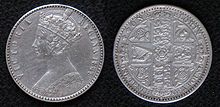
Florin from 1849
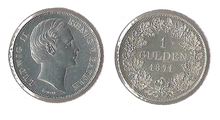
"florins of South German currency" of the Vienna Mint Treaty
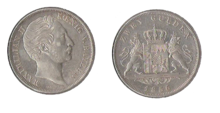
dual florin of the Munich Mint Treaty
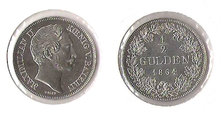
"1/2 florin of South German currency" of the Vienna Mint Treaty.
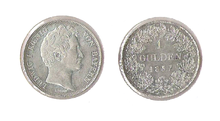
florin of the Munich coinage contract
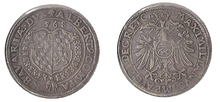
Imperial guilders of Duke Albrecht V of Bavaria Vs.: coat of arms of the Duchy of Bavaria Rs.: imperial eagle with value in the breast shield and inscription (Emperor Maximilian II)
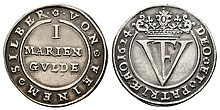
1 Mariengulden 1624, Brunswick-Wolfenbüttel, Friedrich Ulrich (Welter 1058)

1/2 Mariengulden 1624, Brunswick-Wolfenbüttel, Friedrich Ulrich (Welter 1063)
Search within the encyclopedia